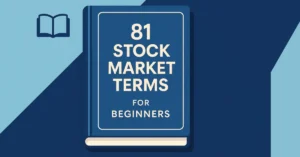Follow Us
What is Free Float?

Free Floating Shares: The Secret Sauce Behind Market Volatility
If you’re knee-deep in the stock market, or even just toe-dipping – you’ve probably come across the term free floating shares.
Here’s the lowdown: Free floating shares are the shares of a company that are available for public trading.
These exclude insider holdings, shares owned by promoters, or any stake locked up by institutions.
Think of it like this: If a stock were a pizza, free floating shares are the slices anyone can grab, while the rest is already reserved for insiders and VIPs.
Why Free Floating Shares Matter
So, why should you care?
Because free float affects liquidity, volatility, and even your ability to get in or out of a trade without pulling your hair out.
1. Liquidity: Can You Actually Trade That Stock?
Liquidity is a stock market term that simply means how easily you can buy or sell without tanking the stock’s price.
High free float = better liquidity.
Let’s compare:
- Company A has a massive free float, millions of shares are up for grabs. You can trade in and out like it’s your favorite online store.
- Company B has a low free float. It’s like trying to buy concert tickets for Taylor Swift – limited supply, high demand, and a chaotic marketplace.
If you are looking to invest in small-cap stocks or niche companies, always check their free float first. A tiny float means even small trades can send prices soaring, or crashing.
2. Volatility: The Rollercoaster Effect
Stocks with a smaller free float tend to be wildcards. A low free float means fewer shares are in circulation, so it takes less buying or selling to move the needle.
If you love adrenaline and don’t mind the risk, low-float stocks are your playground.
But for long-term investors, high volatility might feel more like a headache than an opportunity.
Example:
Imagine two companies:
Company X has 10 million free floating shares, and Company Y has 1 million.
A big investor buying 100,000 shares would barely cause a ripple in Company X. But in Company Y? That same trade could send the stock price into orbit.
3. Index Weighting: Big Floats, Big Impact
Free floating shares also determine how much weight a stock carries in major indices like the S&P 500.
Index funds mimic these indices, so the higher a stock’s free float, the more institutional money flows into it.
In simpler terms, a higher float can mean greater visibility and demand from big players.
How to Spot Free Floating Shares
Checking a stock’s free float isn’t rocket science, it’s right there in the financials.
Most stock market platforms will show you the float percentage, which tells you what fraction of total shares are available for trading.
Here’s the math:
Free Float = Total Shares Outstanding − Restricted Shares
Let’s say a company has 1 million shares outstanding, but 400,000 are locked up by insiders.
That leaves a free float of 600,000 shares, or 60%.
Not bad, but here’s where it gets tricky: The smaller the company, the more this number matters.
The Pros & Cons of Low & High Free Float Stocks
Low Free Float: The Double-Edged Sword
- Pro: Potential for big moves (great for day traders).
- Con: High volatility and low liquidity. Getting stuck in a bad trade is a real risk.
High Free Float: Stability for the Win
- Pro: Less volatility, better liquidity, and fewer pricing surprises.
- Con: Smaller price movements can mean slower returns.
Why Free Float Isn’t the Whole Story
Now, don’t get it twisted, free float is a piece of the puzzle, not the whole picture.
Other factors like market cap, industry trends, and insider activity also play a role.
But ignoring free float is like ignoring the size of a coffee cup when you’re pouring a hot drink. Too little space? You’re going to spill.
What Should You Do?
- Check the Float Before You Trade
Whether you’re investing in the next big tech stock or a penny stock, know the float. It’ll help you predict liquidity and volatility. - Match Your Style to the Float
- Day traders: Hunt for low-float stocks with big price swings.
- Long-term investors: Stick to high-float stocks for stability and liquidity.
- Watch for Float Changes
Companies can issue new shares or buy back existing ones, which alters the free float.
Stay updated, float changes can shake up your strategy.
The Bottom Line
Free floating shares aren’t just a stock market technicality, they’re a vital piece of the investing puzzle.
They dictate how easily you can trade, how wild a stock’s price might swing, and how big institutional players interact with it.
If you’re serious about making smarter trades, stop ignoring the float. Learn it, use it, and start playing the game with your eyes wide open.
Disclaimer:
This content is for informational purposes only and should not be considered financial advice.
Read full Disclaimer.




